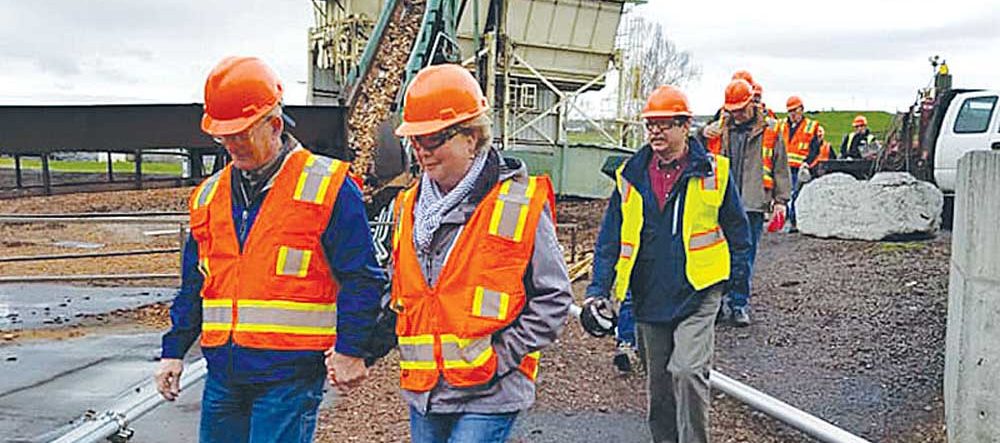Small Oregon city eyes industrial expansion, worrying farmers
Published 8:00 am Friday, June 16, 2023

- A row of onions at Stoneboat Farm, about 2 miles east of North Plains, Ore.
NORTH PLAINS, Ore. — A small Oregon city is pushing to expand its urban growth boundary, or UGB, as the state attempts to lure more semiconductor businesses into the area.
But farmers and land use watchdogs are pushing back, arguing industrial expansion would pave over fertile agricultural land with some of the most productive soils in the world.
The city of North Plains, population 3,424, lies about 20 miles west of Portland along Highway 26. It is surrounded by farms growing a diverse mix of crops — from vast fields of grass seed and wheat to vegetables and berries.
Aaron Nichols, who farms about 15 acres near North Plains, worries the city’s proposed UGB expansion will permanently take prime farmland out of production while setting up future battles for water between existing farms and microchip processors.
“We can’t let small groups of people, especially out-of-state corporations, make gigantic windfalls at the price of being able to feed ourselves in the future,” Nichols said. “That’s just not an acceptable tradeoff.”
City on the grow
According to Portland State University’s Population Research Center, North Plains is expected to nearly double in population by 2035. That makes it one of the fastest growing communities in Washington County.
City leaders began the process of reexamining the urban growth boundary in 2020. A draft report was completed in April, which called for adding about 855 acres into the UGB.
North Plains currently occupies an area of just under 700 acres, or roughly 1 square mile.
The city council will vote June 20 whether to approve the expansion. It must also be approved by the Washington County Board of Commissioners.
Justification for the expansion is outlined in two separate reports — an updated Housing Needs Analysis, which concluded that North Plains would need 167 acres to meet residential demands through 2037, and an Economic Opportunity Analysis, which identified 687 acres needed for commercial and industrial development through 2038.
Andy Varner, North Plains city manager, said the city has already maxed out its current buildable lands inventory.
What’s more, Varner said the city’s tax base is 85-90% residential. By comparison, neighboring Hillsboro has a tax base that is about 40% residential, and 60% non-residential.
“We want to provide services for our community, but we’re financially strapped,” he said. “We don’t recoup enough in taxes to serve every home.”
Computer chips wanted
Efforts to expand North Plains’ UGB have overlapped with the state’s focus on attracting one particular industry — computer chip manufacturers.
Lawmakers passed Senate Bill 4 earlier this year, which sets aside $210 million for grants and loans to semiconductor businesses to purchase and develop land for new facilities.
Another part of the bill gives Gov. Tina Kotek the authority to shift urban growth boundaries to accommodate semiconductor projects. That provision runs through 2024, and contains some sideboards about how much land can moved into a city’s UGB.
Varner said North Plains is interested in becoming a player in the region’s “Silicon Forest.”
“That resonated with our leaders,” he said. “Especially in the semiconductor industry, the ecosystem is very large, with R&D components.”
Highly productive farmland
However, opponents argue that immediate economic desire comes at a potential long-term cost.
“Once you pave farmland, that’s it,” Nichols said. “We lose it.”
What has become clear is just how productive the farmland surrounding North Plains actually is. 1000 Friends of Oregon, a nonprofit organization that focuses on land use planning, reached out to the state Department of Agriculture to review the soils within the proposed UGB expansion.
Jim Johnson, land use and water planning coordinator for ODA, wrote in an email to 1000 Friends of Oregon President Nellie McAdams describing the area as “some of the best farmland in the state,” with highly productive soils.
“What land is not prime is, with minor exceptions, high-value farmland,” Johnson wrote. “Another important factor for almost all the area soils; irrigation does not change (make better) the agriculture soil capability. In other words, these are great agricultural soils with or without irrigation.”
McAdams said the city’s UGB proposal did not adequately consider the loss of such high-value farmland.
“For me, it was very concerning that the city was expanding onto these lands, and they had not done a thorough analysis,” she said.
Agricultural impacts
Nichols is in his ninth season at Stoneboat Farm, about 2 miles east of North Plains. He grows a variety of vegetables sold primarily at local farmers markets and through a community supported agriculture, or CSA, model.
On 15 acres, Nichols said the farm can grow enough food for 500 summer CSA members, which he credits to the fertility of his soils.
He believes the city of North Plains should have done more to consult with farmers on the urban growth boundary expansion. Taking farmland out of production will have a ripple effect on their support industries, such as tractor dealerships, welders and equipment repair specialists.
Semiconductors also require large amounts of water to produce, Nichols said — begging the question of where that water will come from.
“I doubt the area around North Plains has enough water rights to support either a data center or microchip processor,” he said.
Nichols said he hopes these agricultural impacts will be more closely examined by Washington County commissioners at the next step in the approval process.
Varner, the North Plains city manager, said none of the lands studied in the UGB expansion were set aside for rural reserves. After three-plus years of planning, he expected there would be some concerns raised, and the city has been working to answer questions from affected landowners.
“I like vegetables and good clean food, too, but I also know the world also has other demands as well,” he said. “It’s maybe now where there has to be a concerted effort to look at land banking some farmland, working closely with the state and seeing where that might be.”








